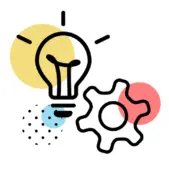Mobile apps have become an integral part of our daily lives. They empower us to accomplish tasks, access information, and stay connected on the go. However, with millions of apps available to users, creating a mobile app that stands out takes more than just technical functionality. A mobile app design that drives user satisfaction and engagement requires thoughtful user interface (UI) and user experience (UX) elements.
In this article, we explore key UI and UX principles that form the foundation of exceptional mobile app design. When you understand and apply these fundamental guidelines, you can craft intuitive, user-centric experiences that keep your audience coming back.
5 Essential UI/UX Principles for Crafting User-Centric Mobile App Experiences
In general, UI and UX describe how users interact with your app. UI is the look and feel of an app, while UX is the overall experience. Together, they impact user sentiment about your product, service, or business.
Successful mobile app design requires a deep understanding of both principles. By adhering to these fundamental guidelines, you can create an intuitive, engaging, and satisfying app.

As you design your mobile app, keep these five essential principles in mind:
- Continuity: Seamless continuity between mobile and desktop experiences is crucial for users. The ability to work on one device and then continue on another is a fundamental expectation.
- Consistency: Consistency helps users quickly orient themselves and perform tasks efficiently. Establish a cohesive design language and interaction patterns throughout your app. Also, use the same UI elements, color schemes, typography, and iconography to create a unified brand experience.
- Simplicity: Avoid cluttered interfaces, unnecessary features, and complex navigation. Aside from implementing responsive design, focus on the core user needs and streamline the experience to deliver maximum value with minimal effort.
- Familiarity: Leverage familiar UI conventions and interaction patterns that users have come to expect from mobile apps. For instance, standard gestures (tapping, swiping, pinching), layout structures (top navigation, bottom tabs), and design elements (buttons, menus, alerts).
- Intuitive Navigation: Ensure your app’s navigation is straightforward to understand. Provide clear visual cues, such as icons and labels, to guide users through the information architecture. Minimize the number of taps or swipes required to access key features and content.
Avoiding Common Mistakes: Pitfalls in Mobile App Design
By not considering the following mobile app design pitfalls, you can hinder usability and engagement. Identify and address these issues early to build a successful app and avoid costly redesigns later.
- Neglecting Performance and Load Times: Optimize your app’s technical infrastructure. Users expect lightning-fast responsiveness from mobile apps. Slow load times, lagging animations, and crashes can quickly drive them away.
- Ignoring User-Centricity: It’s critical to understand your users’ needs, goals, and frustrations. Conduct user research, gather feedback, and design with your users’ perspective in mind, not just your own vision.
- Innovation at the Cost of Usability: Core navigation should remain consistent with established norms to facilitate an efficient UX. For instance, users expect to find the shopping cart in the upper right-hand corner of eCommerce sites. Deviating from this standard can confuse and frustrate users.
- Overlooking Mobile Optimization: Prioritize mobile-specific design. Test your mobile app design across multiple devices to avoid poor UX. Common errors include small buttons that are difficult to tap on compact screens, crowded text, and low-quality images that don’t display well.

Discover These: Overlooked Aspects in Mobile App Design
In a fast-paced working environment, it’s easy to overlook the details of your mobile app design. For instance, unclear or missing states can cause confusion and frustration for users. It’s vital to communicate clearly with users by ensuring you include the following often-neglected elements:
- Empty States: When there’s no content to display, provide the user with meaningful information and optional actions. For example, if they click on the “orders” tab but there’s nothing to show, display a message that says, “You have no pending orders.”
- Error States: Communicate errors, failures, or unexpected situations to the user in a clear and helpful way.
- Onboarding/First-Time User Experience: If the first experience with your app is frustrating, confusing, and requires too much work, users will quickly uninstall it. Ensure the initial setup is easy to navigate and requires minimal effort to get started.
- Loading/Progress States: Include visual indicators and feedback to let the user know when content or actions are being processed.
- Offline/Connectivity States: Decide how the app will behave and communicate with users when there’s no or limited internet connectivity.
When you pay close attention to these often-overlooked states, you can greatly improve the overall mobile user experience and prevent user frustration.
MVP Design: A Step-by-Step Guide
If you’re launching a new mobile app or redesigning an existing one, focusing on a minimum viable product (MVP) is key to efficiently allocate resources, validate assumptions, and quickly bring your product to market. Consider the following steps to establish an MVP for your mobile app design:
- Identify the core problem your app aims to solve, then conduct market research to ensure there’s a demand for your product. A fitness app, for instance, might aim to help users track their progress and improve their fitness routines.
- Define your target audience(s) and identify their core needs, behaviors, and preferences. In our fitness example, this may include fitness enthusiasts and health-conscious individuals.
- Identify the key features your app could have and prioritize only the essential features needed to deliver the core value proposition for the MVP. Here, the fitness app would include activity tracking (steps, distance, calories), workout logging (type, duration, intensity), progress reports, and simple analytics.
- Design the UX by creating wireframes that visualize the app’s layout and flow. Conduct usability testing with prototypes, then make adjustments according to feedback.
- Develop the MVP allowing for changes based on user feedback. Focus on setting a robust and scalable framework for future improvements and developments.
- Conduct extensive testing to identify issues and areas for improvement.
- Launch the MVP to a limited market and track key metrics such as user engagement and retention. Collect user feedback.
- Analyze user feedback and data to identify the most important improvements and additional features to prioritize. Continuously update and enhance the app and stay attuned to user needs and market trends.
When focusing on the MVP, prioritize simplicity, user-centricity, feedback, and scalability. Avoid feature creep by adhering to the app’s core functionality. Ensure the app delivers real value by meeting the target users’ specific needs.
Mobile App Accessibility: Key Aspects and Best Practices
Mobile app accessibility ensures that applications are usable by people with a wide range of abilities and disabilities. Certain key aspects of mobile app design can enhance accessibility, such as:
- Screen Readers: Use TalkBack for Android and VoiceOver for iOS to provide audio feedback for visually impaired users. Use descriptive labels for all interactive elements and ensure content is navigable via screen readers.
- Text Size and Contrast: Allow text size adjustments. Maintain sufficient contrast between text and background.
- Touchable Areas: Make interactive elements large enough for easy tapping. Adhere to platform-specific guidelines (e.g., 44×44 points for iOS).

- Keyboard Navigation: Support keyboard access for users who can’t use touchscreens to ensure interactive elements are also accessible.
- Alternative Inputs: Ensure compatibility with voice control, switches, and other assistive technologies.
- Content Descriptions: Provide text alternatives for non-text content such as images and icons.
- Feedback and Alerts: Use vibration, sound, and visual cues to convey important information.
Mobile App Accessibility Best Practices
Accessibility should be a priority from the start of the design process. The following best practices will help you do this successfully:
- Conduct usability testing, moderated by accessibility experts, with users across the five main categories of disabilities (vision, auditory, physical, cognitive, and speech) to identify potential issues.
- Follow the accessibility guidelines provided by each mobile operating system to ensure your app meets their standards.
- Utilize specialized testing tools such as Accessibility Inspector (iOS) and Accessibility Scanner (Android) to find and fix accessibility problems. Regularly audit your app with these tools.
- Educate and train your design and development teams on accessibility best practices.
- Provide accessibility documentation to help users understand the features available and allow them to customize the app to meet their individual needs.
Mastering Mobile App Design With UpTop
Creating an exceptional mobile app requires a deep understanding of UI and UX principles. Prioritize user-centricity and accessibility and incorporate user feedback for ongoing improvements to create engaging experiences that drive long-term success.
When starting your mobile app design, focus on establishing a strong minimum viable product that delivers core value to your target users. Pay close attention to often-overlooked details like empty states, error messages, and onboarding to reduce frustration and enhance the overall user experience. Also, continuously analyze data, ensure accessibility, and iterate to refine your app and add new features over time.
UpTop’s expertise in mobile app design and UI/UX best practices can help you create an app that resonates with your audience and stands out from competitors. Our UX strategy, product design, and software development experts work closely with you to align your business priorities and user needs.
Are you ready to unlock the potential of innovative mobile app design for lasting success? Connect with us today.


